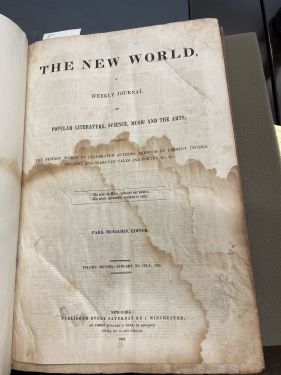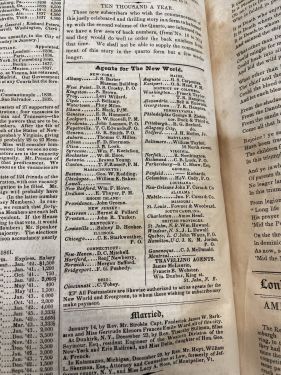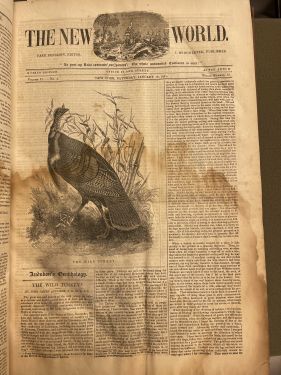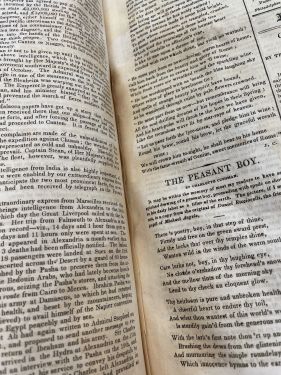The New World: Difference between revisions
No edit summary |
No edit summary |
||
| (3 intermediate revisions by the same user not shown) | |||
| Line 8: | Line 8: | ||
== Background on Newspapers in Early 19th Century America == | == Background on Newspapers in Early 19th Century America == | ||
=== Newspapers role in America === | === Newspapers role in America === | ||
[https://en.wikipedia.org/wiki/Newspaper Newspapers] played a crucial role in America as a developing nation. It served to create informed citizens and also served as a form of entertainment.<ref name="MarketRev"> Douma, Michael J."Newspapers and Knowledge in the Market Revolution." SAGE Business Cases. London: SAGE Publications, Inc., 2022. 4 May 2022, doi: https://dx.doi.org/10.4135/9781526474254. </ref> | [https://en.wikipedia.org/wiki/Newspaper Newspapers] played a crucial role in America as a developing nation. It served to create informed citizens and also served as a form of entertainment.<ref name="MarketRev"> Douma, Michael J."Newspapers and Knowledge in the Market Revolution." SAGE Business Cases. London: SAGE Publications, Inc., 2022. 4 May 2022, doi: https://dx.doi.org/10.4135/9781526474254. </ref> Newspapers developed strong links throughout the country by the spread of information, specifically important for a developing market and cultural identity in a new country. <ref name="MarketRev" /> Information was difficult to obtain and a lot of prior information was obtained by word of mouth. Newspapers enabled a standard form of information to be set on political parties, business prices, and more that enabled the broader population to access this information. Furthermore, the population of America grew rapidly during this time alongside literacy rates which meant that an overall demand for this type of information was created that was previously unavailable.<ref name="Industrial">Musson, A. E. “Newspaper Printing in the Industrial Revolution.” The Economic History Review, vol. 10, no. 3, 1958, pp. 411–26, https://doi.org/10.2307/2591261. Accessed 4 May 2022. </ref> This enabled newspapers to provide this information and fill this need thereby making it possible for profit. | ||
This originally began in only larger cities where production was only available to eventually expanding to a very broad amount of cities across the nation.<ref name="MarketRev" /> During the 19th century, they shifted from a primarily political use where they were owned by political parties to a more independent, unbiased media.<ref name="Politics"> Gerald J. Baldasty & Jeffrey B. Rutenbeck (1988) Money, Politics and Newspapers: The Business Environment of Press Partisanship in the Late 19th Century, Journalism History, 15:2-3, 60-69, DOI: 10.1080/00947679.1988.12066664. </ref> This was necessary to ensure newspapers survival as biased newspapers could easily fail from lack of interest from readers, who were specifically interested in market prices. Furthermore, readers desired more entertainment from provided stories, poems, and more that newspapers began to widely include. Independent newspapers began to rise and began to shift towards a monetization priority of production instead of advancements in political power.<ref name="Politics" /> This was due to the enabling of newspapers as a profitable form of | This originally began in only larger cities where production was only available to eventually expanding to a very broad amount of cities across the nation.<ref name="MarketRev" /> During the 19th century, they shifted from a primarily political use where they were owned by political parties to a more independent, unbiased media.<ref name="Politics"> Gerald J. Baldasty & Jeffrey B. Rutenbeck (1988) Money, Politics and Newspapers: The Business Environment of Press Partisanship in the Late 19th Century, Journalism History, 15:2-3, 60-69, DOI: 10.1080/00947679.1988.12066664. </ref> This was necessary to ensure newspapers survival as biased newspapers could easily fail from lack of interest from readers, who were specifically interested in market prices. Furthermore, readers desired more entertainment from provided stories, poems, and more that newspapers began to widely include. Independent newspapers began to rise and began to shift towards a monetization priority of production instead of advancements in political power.<ref name="Politics" /> This was due to the enabling of newspapers as a profitable form of business.<ref name="MarketRev" /> In fact the editor of St. Joseph News in Missouri stated that “People seem to forget that a newspaper is primarily published as a business enterprise.”<ref name="Politics" /> The use of advertising greatly increased and led to newspapers using this as their primary means of profit.<ref name="Industrial" /> A large surplus of American newspapers began to influx and challenged the previous standard of London newspapers.<ref name="Industrial" /> Newspapers circulation also greatly increased leading to surpluses of copies to be released into the market that was previously unavailable. | ||
=== The Industrial Revolution's Influence on Newspapers === | === The Industrial Revolution's Influence on Newspapers === | ||
| Line 18: | Line 18: | ||
== Park Benjamin == | == Park Benjamin == | ||
[[File:ParkBenjamin WikiProject.jpg| | [[File:ParkBenjamin WikiProject.jpg|150px|thumb|right|Engraving of Park Benjamin]] | ||
[https://en.wikipedia.org/wiki/Park_Benjamin_Sr. Park Benjamin] was born in 1809 and at an early age had an inflection that left him lame with shrunken limbs.<ref name="Park">Prabook.com. 2022. Park Benjamin. [online] Available at: <https://prabook.com/web/park.benjamin/1079847> [Accessed 4 May 2022]. </ref> He received schooling in Connecticut and Massachusetts before attending [https://en.wikipedia.org/wiki/Harvard_University Harvard University] and graduating at what is now known as [https://en.wikipedia.org/wiki/Trinity_College_(Connecticut) Trinity College]. His first work was the Norwich Spector that survived for ten issues where he then attended Harvard Law and graduated from Yale Law in 1832.<ref name="Park" /> He then practiced law for a short time before he began The Harbinger which was a collection of poems from himself and some classmates and then became the editor and owner of the New England Magazine after.<ref name="Park" /> This then merged with American monthly magazine in New York where he was associated in editorship where it then failed in 1838. He then took up his largest and most successful project, ''The New World'' which survived until 1845.<ref name="Park" /> This was a work that reprinted British works without remuneration to the authors. After its discontinuation he started a few small undertakings that never took off and lived a quiet life in New York.<ref name="Park" /> He was noted for his abusive nature towards rival editors and authors and was even sued for libel.<ref name="Park" /> | [https://en.wikipedia.org/wiki/Park_Benjamin_Sr. Park Benjamin] was born in 1809 and at an early age had an inflection that left him lame with shrunken limbs.<ref name="Park">Prabook.com. 2022. Park Benjamin. [online] Available at: <https://prabook.com/web/park.benjamin/1079847> [Accessed 4 May 2022]. </ref> He received schooling in Connecticut and Massachusetts before attending [https://en.wikipedia.org/wiki/Harvard_University Harvard University] and graduating at what is now known as [https://en.wikipedia.org/wiki/Trinity_College_(Connecticut) Trinity College]. His first work was the Norwich Spector that survived for ten issues where he then attended Harvard Law and graduated from Yale Law in 1832.<ref name="Park" /> He then practiced law for a short time before he began The Harbinger which was a collection of poems from himself and some classmates and then became the editor and owner of the New England Magazine after.<ref name="Park" /> This then merged with American monthly magazine in New York where he was associated in editorship where it then failed in 1838. He then took up his largest and most successful project, ''The New World'' which survived until 1845.<ref name="Park" /> This was a work that reprinted British works without remuneration to the authors. After its discontinuation he started a few small undertakings that never took off and lived a quiet life in New York.<ref name="Park" /> He was also noted for his abusive nature towards rival editors and authors and was even sued for libel.<ref name="Park" /> | ||
== Book Content and Context == | == Book Content and Context == | ||
The book is a codex-form ephemeral of ''The New World'' by editor, Park Benjamin and publisher, Jonas Winchester. It is a collection of each weekly edition from January to July of 1841. With the book, there is an included title page and an index that is highly detailed and lists each edition. There are a total of at least 418 pages included in the work. The newspaper is a collection of works from authors, sermons, tales, poetry, political information, and much more. This demonstrated the broad net that Park Benjamin casted out to attract as many viewers as possible. The works themselves largely derived from British artists even though ''The New World'' is playing towards a newly created cultural identity within America that largely feels inferior to Britain. Each edition also included the 3$ annum subscription in the top right of the title which demonstrates the largely accessible price for the viewers. Clearly, Park Benjamin was targeting lower income families for subscription instead of more elite, literate | The book is a codex-form ephemeral of ''The New World'' by editor, Park Benjamin and publisher, Jonas Winchester. It is a collection of each weekly edition from January to July of 1841. With the book, there is an included title page and an index that is highly detailed and lists each edition. There are a total of at least 418 pages included in the work. The newspaper is a collection of works from authors, sermons, tales, poetry, political information, and much more. This demonstrated the broad net that Park Benjamin casted out to attract as many viewers as possible. The works themselves largely derived from British artists even though ''The New World'' is playing towards a newly created cultural identity within America that largely feels inferior to Britain. Each edition also included the 3$ annum subscription in the top right of the title which demonstrates the largely accessible price for the viewers. Clearly, Park Benjamin was targeting lower income families for subscription instead of more historically elite, exclusively literate readers. This points to the increasing literacy rates within America and the expansive new group of consumers that are available. This is especially due to a large portion of profit coming from the advertisements for this class and not the subscriptions themselves. Park Benjamin also had national ambitions to move it from being just locally in New York. This can be seen in the newspapers themselves where there are lists of agents and offices throughout the country. There are even references to agents within Britain that are reporting news, pointing to potentially even international ambitions. Yet the lax postal laws that enabled the rapid expansion of this paper were conferred which hastened the downfall of ''The New World'' in the already volatile newspaper market. <ref name="Industrial" /> | ||
<gallery mode="packed" perrow=2 heights= | <gallery mode="packed" perrow=2 heights=250px> | ||
Image:TitlePage TheNewWorld.jpg|A photo of the Title Page of the book The New World | Image:TitlePage TheNewWorld.jpg|A photo of the Title Page of the book The New World | ||
Image:Index TheNewWorld.jpg| Index of the New World that is highly detailed listing every weekly edition | Image:Index TheNewWorld.jpg| Index of the New World that is highly detailed listing every weekly edition | ||
| Line 31: | Line 31: | ||
</gallery> | </gallery> | ||
== Material Analysis == | == Material Analysis == | ||
The cover of the book as well as its sheer size that was measured to be 15.5inches x 10 inches was the first noticed. Before this discussion though, the collection was found to have serious water damage remaining on many of the interior pages. This is important to note because it likely explains the book's cover being a brown-colored canvas attached to a board binding that came from the library. The reason the cover was likely replaced was due to water damage. The original book likely came in an embroidered or grained, leather binding that fit the style of book bindings in the 1850s. When leather is exposed to water, it can easily begin to crack and decay that can lead to its structural instability as well as a putrid smell. The evidence of water damage suggests that the book was potentially even submerged during the incident and undoubtedly called for the book cover’s removal, as unfortunate as it is. The cover itself came likely in the mid 20th century and featured gold-tooled labeled lettering on the side that details the book title and library ID. The interior of the book was found to have a thick blank first and last page from the library. The actual pages apart from the original book were found to be extremely thin, cheap pages that are not durable which fits the ephemeral nature of newspapers. It also fits the notion that economic efficiency for profit was the primary concern, so cheaper paper to save on expenses makes sense. There were also notable pages appearing to be ripped out or potentially just degraded from the binding. Each newspaper utilized a three column format with condensed lettering that maximized the amount of space used on each page. The highly regimented and smaller lettering demonstrated a desire to achieve the optimal amount of subject matter onto the page without compromising the readability of the pages. The Industrial Revolution helped lead to this more efficient packing of material into the pages due to the increased efficiency of the printing beds. This led to the maximization of stories and works to be included within the newspaper. The newspaper also had a dedicated [https://en.wikipedia.org/wiki/Woodblock_printing woodblock] on every cover page, as well as included some special woodblocks made on the front pages that had to be extremely durable to withstand the mass production process. This was costly for the time and demonstrated the balance of economic efficiency of saving money while also trying to stand out from their competitors. This included prints like a turkey and cathedral on two different weekly editions. Similarly, Gothic style print was also seen throughout the piece that added to its more luxurious appearance. Thus, it points to investments being made in the material towards driving more viewership. Finally noticeable typos were made in the process which points to human error still being present in the placement of the letters even within the more mechanized process from the Industrial Era. This can be seen in the printing of the “UARTO EDITION” | [[File:Typo TheNewWorld.jpg|250px|thumb|Typo of Quarto in the heading of a periodical with visible water damage]] | ||
The cover of the book as well as its sheer size that was measured to be 15.5inches x 10 inches was the first noticed. Before this discussion though, the collection was found to have serious water damage remaining on many of the interior pages. This is important to note because it likely explains the book's cover being a brown-colored canvas attached to a board binding that came from the library. The reason the cover was likely replaced was due to water damage. The original book likely came in an embroidered or grained, leather binding that fit the style of book bindings in the 1850s. When leather is exposed to water, it can easily begin to crack and decay that can lead to its structural instability as well as a putrid smell. The evidence of water damage suggests that the book was potentially even submerged during the incident and undoubtedly called for the book cover’s removal, as unfortunate as it is. The cover itself came likely in the mid 20th century and featured gold-tooled labeled lettering on the side that details the book title and library ID. The interior of the book was found to have a thick blank first and last page from the library. The actual pages apart from the original book were found to be extremely thin, cheap pages that are not durable which fits the ephemeral nature of newspapers. It also fits the notion that economic efficiency for profit was the primary concern, so cheaper paper to save on expenses makes sense. There were also notable pages appearing to be ripped out or potentially just degraded from the binding. Each newspaper utilized a three column format with condensed lettering that maximized the amount of space used on each page. The highly regimented and smaller lettering demonstrated a desire to achieve the optimal amount of subject matter onto the page without compromising the readability of the pages. The Industrial Revolution helped lead to this more efficient packing of material into the pages due to the increased efficiency of the printing beds. This led to the maximization of stories and works to be included within the newspaper. The newspaper also had a dedicated [https://en.wikipedia.org/wiki/Woodblock_printing woodblock] on every cover page, as well as included some special woodblocks made on the front pages that had to be extremely durable to withstand the mass production process. This was costly for the time and demonstrated the balance of economic efficiency of saving money while also trying to stand out from their competitors. This included prints like a turkey and cathedral on two different weekly editions. Similarly, Gothic style print was also seen throughout the piece that added to its more luxurious appearance. Thus, it points to investments being made in the material towards driving more viewership. Finally noticeable typos were made in the process which points to human error still being present in the placement of the letters even within the more mechanized process from the Industrial Era. This can be seen in the printing of the “UARTO EDITION” instead of “QUARTO EDITION” for one of the papers. | |||
Each weekly edition is an eight page edition made up of [https://en.wikipedia.org/wiki/Quarto quarto] style pages made from a much larger paper that fits the trend of the Industrial Era using extremely large papers in the press beds. On all of the eight pages, there is no free space left except for the outer boundaries. | Each weekly edition is an eight page edition made up of [https://en.wikipedia.org/wiki/Quarto quarto] style pages made from a much larger paper that fits the trend of the Industrial Era using extremely large papers in the press beds. On all of the eight pages, there is no free space left except for the outer boundaries. | ||
<gallery mode="packed" perrow=2 heights= | <gallery mode="packed" perrow=2 heights=250px> | ||
Image:TurkeyWoodblock TheNewWorld.jpg|Woodblock of a turkey on front page | Image:TurkeyWoodblock TheNewWorld.jpg|Woodblock of a turkey on front page | ||
Image:PageRipped TheNewWorld.jpg| Ripped page in the New World | Image:PageRipped TheNewWorld.jpg| Ripped page in the New World | ||
</gallery> | </gallery> | ||
| Line 42: | Line 43: | ||
[[File:Donation TheNewWorld.jpg|200px|left|thumb|A photo of the donation note from the Ashurts to the Philomathean Society in May of 1855]] | [[File:Donation TheNewWorld.jpg|200px|left|thumb|A photo of the donation note from the Ashurts to the Philomathean Society in May of 1855]] | ||
The book has a note on the front interior cover that details the book’s compilation and donation by John Ashurst Jr. and Richard L. Ashurst in May of 1855 to the [https://en.wikipedia.org/wiki/Philomathean_Society Philomathean Society] where it was first introduced to the University of Pennsylvania and has remained in its libraries since then. The Philomathean Society expressed a deep interest in books and their historical significance as they contained invaluable information. In an address to their society it was stated “The youth, who feels no sacred thirst for knowledge, whose dull ear finds no voice in nature, who reads without interest the histories of pages ages… wastes here that time which might be better spent in tasks for which his sluggish nature fits him.”<ref name="Address"> Bethune, George W. An Address Before the Philomathean Society of the University of Pennsylvania. [Buffalo, NY]: William S. Hein & Co., 2010. </ref> It was first founded in 1813 and has student autonomy where they have contributed works like in the English translation of the Rosetta Stone or the creative of comparative literature departments at the university.<ref name="Philomathean"> Philomathean.org. 2022. Philomathean Society. [online] Available at: <http://philomathean.org/> [Accessed 4 May 2022].</ref> The Philomathean society seems like the ample place to donate such an important work. Its ability to be preserved instead of deteriorating away to be lost forever due to the ephemeral nature of its existence, enables university students today to | The book has a note on the front interior cover that details the book’s compilation and donation by John Ashurst Jr. and Richard L. Ashurst in May of 1855 to the [https://en.wikipedia.org/wiki/Philomathean_Society Philomathean Society] where it was first introduced to the University of Pennsylvania and has remained in its libraries since then. The Philomathean Society expressed a deep interest in books and their historical significance as they contained invaluable information. In an address to their society it was stated “The youth, who feels no sacred thirst for knowledge, whose dull ear finds no voice in nature, who reads without interest the histories of pages ages… wastes here that time which might be better spent in tasks for which his sluggish nature fits him.”<ref name="Address"> Bethune, George W. An Address Before the Philomathean Society of the University of Pennsylvania. [Buffalo, NY]: William S. Hein & Co., 2010. </ref> It was first founded in 1813 and has student autonomy where they have contributed works like in the English translation of the Rosetta Stone or the creative of comparative literature departments at the university.<ref name="Philomathean"> Philomathean.org. 2022. Philomathean Society. [online] Available at: <http://philomathean.org/> [Accessed 4 May 2022].</ref> The Philomathean society seems like the ample place to donate such an important work. Its ability to be preserved instead of deteriorating away to be lost forever due to the ephemeral nature of its existence, enables university students today to access its contents. Thus, important works that are staples of early 19th century America are able to be enjoyed today. | ||
== References == | == References == | ||
Latest revision as of 22:13, 4 May 2022
Introduction

Opening the book illuminated the grand title page for the collection of weekly periodicals from January to July of 1841 of The New World with editor Park Benjamin and publisher J. Winchester. It currently resides in University of Pennsylvania's Kislak Center for Special Collections, Rare Books and Manuscripts. The collection details early-mid 19th century culture within America in relation to the vast amount of historically important content in the periodicals. The newspaper also gives insight to how America expanded through its influence on markets as well as its cultural impact.
Background on Newspapers in Early 19th Century America
Newspapers role in America
Newspapers played a crucial role in America as a developing nation. It served to create informed citizens and also served as a form of entertainment.[1] Newspapers developed strong links throughout the country by the spread of information, specifically important for a developing market and cultural identity in a new country. [1] Information was difficult to obtain and a lot of prior information was obtained by word of mouth. Newspapers enabled a standard form of information to be set on political parties, business prices, and more that enabled the broader population to access this information. Furthermore, the population of America grew rapidly during this time alongside literacy rates which meant that an overall demand for this type of information was created that was previously unavailable.[2] This enabled newspapers to provide this information and fill this need thereby making it possible for profit.
This originally began in only larger cities where production was only available to eventually expanding to a very broad amount of cities across the nation.[1] During the 19th century, they shifted from a primarily political use where they were owned by political parties to a more independent, unbiased media.[3] This was necessary to ensure newspapers survival as biased newspapers could easily fail from lack of interest from readers, who were specifically interested in market prices. Furthermore, readers desired more entertainment from provided stories, poems, and more that newspapers began to widely include. Independent newspapers began to rise and began to shift towards a monetization priority of production instead of advancements in political power.[3] This was due to the enabling of newspapers as a profitable form of business.[1] In fact the editor of St. Joseph News in Missouri stated that “People seem to forget that a newspaper is primarily published as a business enterprise.”[3] The use of advertising greatly increased and led to newspapers using this as their primary means of profit.[2] A large surplus of American newspapers began to influx and challenged the previous standard of London newspapers.[2] Newspapers circulation also greatly increased leading to surpluses of copies to be released into the market that was previously unavailable.
The Industrial Revolution's Influence on Newspapers
The Industrial Revolution provided great leaps forward for the advancement of newspaper production to meet the large demand from the growing American population. It led to newspapers rapidly growing in size and circulation, revolutionized their means of gathering news, mechanized printing, and finally transformed the look.[2] Firstly, changes in locomotion affected the collection of information. Previously, information would be gathered by Stagecoach or horse relay, and instead the advancements in locomotion made its collection much more rapid.[2] News from much wider spans of areas and the rate at which it was collected enabled newspapers to expand their operations. In fact, they could then rival the previously dominant London Press as well as begin to shift their view from local influence to potentially national or even internationally.[2]
The methods of newspaper printing also were required to be revolutionized. Previously the hand press and hand composition were often too slow and could not handle the larger demands of the time. This was utilized primarily until the 1820s were it began to be shifted towards mechanized production.[2] The initial method utilized a hand-press and a composition hand laying type which was then printed on single, one sided sheets.[2] The first innovation came in 1811 with the steam-driven cylinder printing machine that had reciprocating movement of the type bed, utilization of a cylinder for impression onto the paper, and automatic inking of the forme by rollers where it was fed and removed by hand.[2] In 1827 four feeding stations and impression cylinder machine were made which enabled much faster production that a variety of newspapers began to employ.[2] Furthermore, the printing of larger sheets that were scaled as large as the machines could handle were utilized and the machines themselves were able to print on these pages much more precisely and in a more superior style.[2] Overall, the Industrial Revolution enabled the steam-powered automation of large press ends that converted newspapers from labor intensive, hand worked sheets to a multi-paged paper that are mechanized and creatively prepared by folds and cuts that produced a much faster rate of newspapers production that better fit the needs of the times.
Park Benjamin
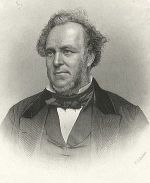
Park Benjamin was born in 1809 and at an early age had an inflection that left him lame with shrunken limbs.[4] He received schooling in Connecticut and Massachusetts before attending Harvard University and graduating at what is now known as Trinity College. His first work was the Norwich Spector that survived for ten issues where he then attended Harvard Law and graduated from Yale Law in 1832.[4] He then practiced law for a short time before he began The Harbinger which was a collection of poems from himself and some classmates and then became the editor and owner of the New England Magazine after.[4] This then merged with American monthly magazine in New York where he was associated in editorship where it then failed in 1838. He then took up his largest and most successful project, The New World which survived until 1845.[4] This was a work that reprinted British works without remuneration to the authors. After its discontinuation he started a few small undertakings that never took off and lived a quiet life in New York.[4] He was also noted for his abusive nature towards rival editors and authors and was even sued for libel.[4]
Book Content and Context
The book is a codex-form ephemeral of The New World by editor, Park Benjamin and publisher, Jonas Winchester. It is a collection of each weekly edition from January to July of 1841. With the book, there is an included title page and an index that is highly detailed and lists each edition. There are a total of at least 418 pages included in the work. The newspaper is a collection of works from authors, sermons, tales, poetry, political information, and much more. This demonstrated the broad net that Park Benjamin casted out to attract as many viewers as possible. The works themselves largely derived from British artists even though The New World is playing towards a newly created cultural identity within America that largely feels inferior to Britain. Each edition also included the 3$ annum subscription in the top right of the title which demonstrates the largely accessible price for the viewers. Clearly, Park Benjamin was targeting lower income families for subscription instead of more historically elite, exclusively literate readers. This points to the increasing literacy rates within America and the expansive new group of consumers that are available. This is especially due to a large portion of profit coming from the advertisements for this class and not the subscriptions themselves. Park Benjamin also had national ambitions to move it from being just locally in New York. This can be seen in the newspapers themselves where there are lists of agents and offices throughout the country. There are even references to agents within Britain that are reporting news, pointing to potentially even international ambitions. Yet the lax postal laws that enabled the rapid expansion of this paper were conferred which hastened the downfall of The New World in the already volatile newspaper market. [2]
-
A photo of the Title Page of the book The New World
-
Index of the New World that is highly detailed listing every weekly edition
-
List of Agents in the New World
Material Analysis
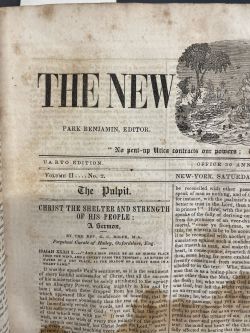
The cover of the book as well as its sheer size that was measured to be 15.5inches x 10 inches was the first noticed. Before this discussion though, the collection was found to have serious water damage remaining on many of the interior pages. This is important to note because it likely explains the book's cover being a brown-colored canvas attached to a board binding that came from the library. The reason the cover was likely replaced was due to water damage. The original book likely came in an embroidered or grained, leather binding that fit the style of book bindings in the 1850s. When leather is exposed to water, it can easily begin to crack and decay that can lead to its structural instability as well as a putrid smell. The evidence of water damage suggests that the book was potentially even submerged during the incident and undoubtedly called for the book cover’s removal, as unfortunate as it is. The cover itself came likely in the mid 20th century and featured gold-tooled labeled lettering on the side that details the book title and library ID. The interior of the book was found to have a thick blank first and last page from the library. The actual pages apart from the original book were found to be extremely thin, cheap pages that are not durable which fits the ephemeral nature of newspapers. It also fits the notion that economic efficiency for profit was the primary concern, so cheaper paper to save on expenses makes sense. There were also notable pages appearing to be ripped out or potentially just degraded from the binding. Each newspaper utilized a three column format with condensed lettering that maximized the amount of space used on each page. The highly regimented and smaller lettering demonstrated a desire to achieve the optimal amount of subject matter onto the page without compromising the readability of the pages. The Industrial Revolution helped lead to this more efficient packing of material into the pages due to the increased efficiency of the printing beds. This led to the maximization of stories and works to be included within the newspaper. The newspaper also had a dedicated woodblock on every cover page, as well as included some special woodblocks made on the front pages that had to be extremely durable to withstand the mass production process. This was costly for the time and demonstrated the balance of economic efficiency of saving money while also trying to stand out from their competitors. This included prints like a turkey and cathedral on two different weekly editions. Similarly, Gothic style print was also seen throughout the piece that added to its more luxurious appearance. Thus, it points to investments being made in the material towards driving more viewership. Finally noticeable typos were made in the process which points to human error still being present in the placement of the letters even within the more mechanized process from the Industrial Era. This can be seen in the printing of the “UARTO EDITION” instead of “QUARTO EDITION” for one of the papers. Each weekly edition is an eight page edition made up of quarto style pages made from a much larger paper that fits the trend of the Industrial Era using extremely large papers in the press beds. On all of the eight pages, there is no free space left except for the outer boundaries.
-
Woodblock of a turkey on front page
-
Ripped page in the New World
Philomathean Society Donation and Introduction to Penn
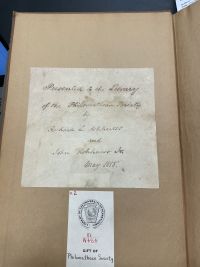
The book has a note on the front interior cover that details the book’s compilation and donation by John Ashurst Jr. and Richard L. Ashurst in May of 1855 to the Philomathean Society where it was first introduced to the University of Pennsylvania and has remained in its libraries since then. The Philomathean Society expressed a deep interest in books and their historical significance as they contained invaluable information. In an address to their society it was stated “The youth, who feels no sacred thirst for knowledge, whose dull ear finds no voice in nature, who reads without interest the histories of pages ages… wastes here that time which might be better spent in tasks for which his sluggish nature fits him.”[5] It was first founded in 1813 and has student autonomy where they have contributed works like in the English translation of the Rosetta Stone or the creative of comparative literature departments at the university.[6] The Philomathean society seems like the ample place to donate such an important work. Its ability to be preserved instead of deteriorating away to be lost forever due to the ephemeral nature of its existence, enables university students today to access its contents. Thus, important works that are staples of early 19th century America are able to be enjoyed today.
References
- ↑ 1.0 1.1 1.2 1.3 Douma, Michael J."Newspapers and Knowledge in the Market Revolution." SAGE Business Cases. London: SAGE Publications, Inc., 2022. 4 May 2022, doi: https://dx.doi.org/10.4135/9781526474254.
- ↑ 2.00 2.01 2.02 2.03 2.04 2.05 2.06 2.07 2.08 2.09 2.10 2.11 Musson, A. E. “Newspaper Printing in the Industrial Revolution.” The Economic History Review, vol. 10, no. 3, 1958, pp. 411–26, https://doi.org/10.2307/2591261. Accessed 4 May 2022.
- ↑ 3.0 3.1 3.2 Gerald J. Baldasty & Jeffrey B. Rutenbeck (1988) Money, Politics and Newspapers: The Business Environment of Press Partisanship in the Late 19th Century, Journalism History, 15:2-3, 60-69, DOI: 10.1080/00947679.1988.12066664.
- ↑ 4.0 4.1 4.2 4.3 4.4 4.5 Prabook.com. 2022. Park Benjamin. [online] Available at: <https://prabook.com/web/park.benjamin/1079847> [Accessed 4 May 2022].
- ↑ Bethune, George W. An Address Before the Philomathean Society of the University of Pennsylvania. [Buffalo, NY]: William S. Hein & Co., 2010.
- ↑ Philomathean.org. 2022. Philomathean Society. [online] Available at: <http://philomathean.org/> [Accessed 4 May 2022].
